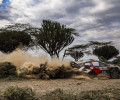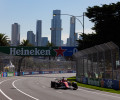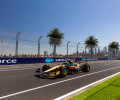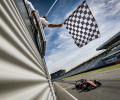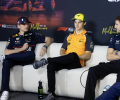German Grand Prix - Preview
16.07.14

|
|
|
|
|
Race Preview |
||
|
2014 GERMAN GRAND PRIX 18 – 20 JULY 2014 |
||
|
Following an enthralling grand prix at Silverstone, the 2014 Formula One season this weekend reaches its midpoint, with round 10 of the championship – the German Grand Prix at Hockenheim. The Hockenheimring presents teams with a number of tricky challenges, especially in terms of this year’s new technology. While the long, power hungry, forest straights of the old circuit were consigned to history in 2002, the current layout, which see the cars reach over 280kph on three occasions in the opening section alone, continues to provide a stern test for powerplants. In F1’s last outing here in 2012 drivers were at full throttle for two-thirds of every lap, meaning that power units are likely to be severely tested here. Fuel consumption could also be a concern this year. Not only are cars at full throttle for long periods but the heavy braking needed for the hairpin and the twisty nature of the infield section mean that the circuit is a thirsty one. With drivers limited to 100kg of fuel for the race and a flow limit of 100kg/hour, clever race management could be crucial this weekend. That shouldn’t mean a lack of excitement, however. The track has two inviting overtaking points at the hairpin (Turn Six) and Turn Eight and with two DRS zones in place at the circuit for the first time, this year’s grand prix could prove to be action-packed. As the season reaches the halfway mark, the battle for the drivers’ title is delicately balanced. Lewis Hamilton’s win on home soil in Britain drew him to within four points of team-mate and championship leader Nico Rosberg. The German will be hoping to emulate his team-mate’s Silverstone feat and re-establish a gap at the top of the standings with a home win for himself and Mercedes. Hamilton, buoyed by his fifth victory of the season will be doing everything in his power to claim that home Silver Arrows’ win for himself. |
 |
|
|
CIRCUIT DATA HOCKENHEIMRING Length of lap: 5.574km Lap record 1:13.780 (Kimi Räikkönen, McLaren, 2004) Start line/finish line offset 0.000km Total number of race laps 67 Total race distance 306.458km Pitlane speed limits 80km/h in practice, qualifying and the race CIRCUIT NOTES ► A one-metre wide strip of Grasscrete has been laid next to the track surface on the approach to Turn One. ► In order to prevent further damage to the grass verge at Turn 15, a 50mm high combination kerb has been laid behind the kerb on the apex. ► Drainage has now been provided in the drag strip around the outside of Turn 17, This should prevent the accumulation of water there. DRS ZONES ► There will be two DRS zones. The detection point of the first is 110m before Turn One, with the activation point 60m after Turn One. The second detection point is at the exit of Turn Four, with the activation point 260m after Turn Four. |
||
|
|
||
 |
||
|
|
||
|
German GP Fast Facts |
||
|
► This will be the 61st German Grand Prix of the Formula One Championship era. ► It will be the 34th time the race has been run at Hockenheim. Two other circuits have hosted the grand prix. The Nürburgring has staged the race 26 times across a number of periods (1951-’54, 1956-’58, 1961-’69, 1971-’76, 1985 and in alternate years from 2009 onwards). The only other venue for the race was Berlin’s AVUS circuit, which hosted a single grand prix, in 1959. That race is unique in that the grand prix was run as two heats, with victory awarded on aggregate performance. It resulted in an all-Ferrari podium, with Briton Tony Brooks victorious ahead of Americans Dan Gurney and Phil Hill. ► Hockenheim made its Formula One calendar debut on August 2, 1970. The race had been switched to the Baden-Württemberg circuit due to safety concerns about the Nürburging and was won by Jochen Rindt. It was his final F1 win before his tragic death, five weeks later, in practice for the Italian Grand Prix. |
► When Niki Lauda’s crash at the Nürburging brought to an end the Nordschleife’s time as a German Grand Prix venue, Hockenheim took over, hosting the race from 1977-1984 and then in an unbroken run from 1986 until 2006. No German GP was held in 2007 and when the race returned in 2008, Hockenheim staged the first race of an event-sharing agreement with the Nürburgring. ► Michael Schumacher has the most German GP wins, all coming at Hockenheim (1995 for Benetton and in 2002, 2004 and 2006 for Ferrari). Five drivers have won this event three times: Juan Manuel Fangio, Jackie Stewart, Nelson Piquet, Ayrton Senna and Fernando Alonso. ► Despite the race-sharing agreement of the past seven years, all three of Alonso’s German victories have come at the Hockenheimring. He took his first here with Renault in 2005 and won for Ferrari in 2010 and 2012. |
► Lewis Hamilton is the only other multiple winner in the current F1 driver line-up. He won here in 2008 and at the Nürburgring in 2011. ► Only three German drivers have won their home grand prix. As mentioned, Michael Schumacher won four times. His brother Ralf took victory for Williams-BMW in 2001 and Red Bull Racing’s Sebastian Vettel won at home, at the sixth attempt, last year. ► German drivers have, however, won a total of 148 F1 grands prix. Michael Schumacher’s 91 wins are complemented by wins for Wolfgang von Trips (2); Jochen Mass (1); Heinz-Harald Frentzen (3); Ralf Schumacher (6), Sebastian Vettel (39) and Nico Rosberg (6). ► Since the debut of the redesigned circuit in 2002, Hockenheim has staged the race eight times. Five have been won from pole position. The 2006 and 2010 events were won from second and just one win has been scored from off the front row – Alonso, from third in 2005. |
|
|
||
|
German GP Race Stewards Biographies |
||
|
GARRY CONNELLY DEPUTY PRESIDENT, FIA INSTITUTE; DIRECTOR, AUSTRALIAN INSTITUTE OF MOTOR SPORT SAFETY; F1 AND WTCC STEWARD; FIA WORLD MOTOR SPORT COUNCIL MEMBER |
 |
|
| Garry Connelly has been involved in motor sport since the late 1960s. A long-time rally competitor, Connelly was instrumental in bringing the World Rally Championship to Australia in 1988 and served as Chairman of the Organising Committee, Board member and Clerk of Course of Rally Australia until December 2002. He has been an FIA Steward and FIA Observer since 1989, covering the FIA’s World Rally Championship, World Touring Car Championship and Formula One Championship. He is a director of the Australian Institute of Motor Sport Safety and a member of the FIA World Motor Sport Council. | ||
|
|
||
|
VINCENZO SPANO PRESIDENT OF THE SPORTING COMMISSION OF THE AUTOMOBILE AND TOURING CLUB OF VENEZUELA |
 |
|
| Italian-born Vincenzo Spano grew up in Venezuela, where he went on to study at the Universidad Central de Venezuela, becoming an attorney-at-law. Spano has wide-ranging experience in motor sport, from national to international level. He has worked for the Touring y Automóvil Club de Venezuela since 1991, and served as President of the Sporting Commission since 2001. He was president for two terms and now sits as a member of the Board of the Nacam-FIA zone. Since 1995 Spano has been a licenced steward and obtained his FIA steward superlicence in 2003.Spano has been involved with the FIA and FIA Institute in various roles since 2001: a member of the World Motor Sport Council, the FIA Committee, and the executive committee of the FIA Institute. | ||
|
|
||
|
TOM KRISTENSEN
NINE TIMES LE MANS WINNER, GERMAN F3 CHAMPION (1991), JAPANESE F3 CHAMPION (1993) ALMS CHAMPION (2001)
|
 |
|
| Denmark’s Tom Kristensen is the most successful driver in the history of the Le Mans 24-Hour race. He has won the classic endurance event nine times, racing for Porsche, Audi and Bentley. Kristensen, 47, has a broad racing CV, having competed in single- seaters, touring cars and a range of sportscars. He has also tested in F1. Having won his ninth 24 Hours of Le Mans and claimed the FIA World Endurance Championship title last year, Kristensen is back for more WEC action this year, again racing for Audi Sport Team Joest. However, following the retirement of Allan McNish, Kristensen is this season partnered by Loïc Duval and Lucas Di Grassi, though Duval was replaced at the recent Le Mans 24 Hours by Marc Gene following an accident in practice. | ||
|
|
||
|
German GP Championship Standings (Drivers) |
||
 |
||
|
|
||
|
German GP Championship Standings (Constructors) |
||
 |
||
|
|
||
|
German GP Formula One Timetable & FIA Media Schedule |
||
|
|
||
|
THURSDAY Press Conference FRIDAY Practice Session 1 Practice Session 2 Press Conference SATURDAY Practice Session 3 Qualifying Followed by unilateral and press conference SUNDAY Drivers' Parade Race Followed by podium interviews and press conference |
15.00 10.00-11.30 14.00-15.30 16.00 11.00-12.00 14.00-15.00 12.30 14.00-16.00 |
|
|
|
||
| ADDITIONAL MEDIA OPPORTUNITIES | ||
|
QUALIFYING All drivers eliminated in Q1 or Q2 are available for media interviews immediately after the end of each session, as are drivers who participated in Q3, but who are not required for the post-qualifying press conference. The TV pen interview area will be located next to the FIA Hospitality unit, behind the FIA garage, paddock side. RACE Any driver retiring before the end of the race will be made available at his team’s garage/hospitality. In addition, during the race every team will make available at least one senior spokesperson for interview by officially accredited TV crews. A list of those nominated will be made available in the media centre. |
||

 Facebook
Facebook Twitter
Twitter